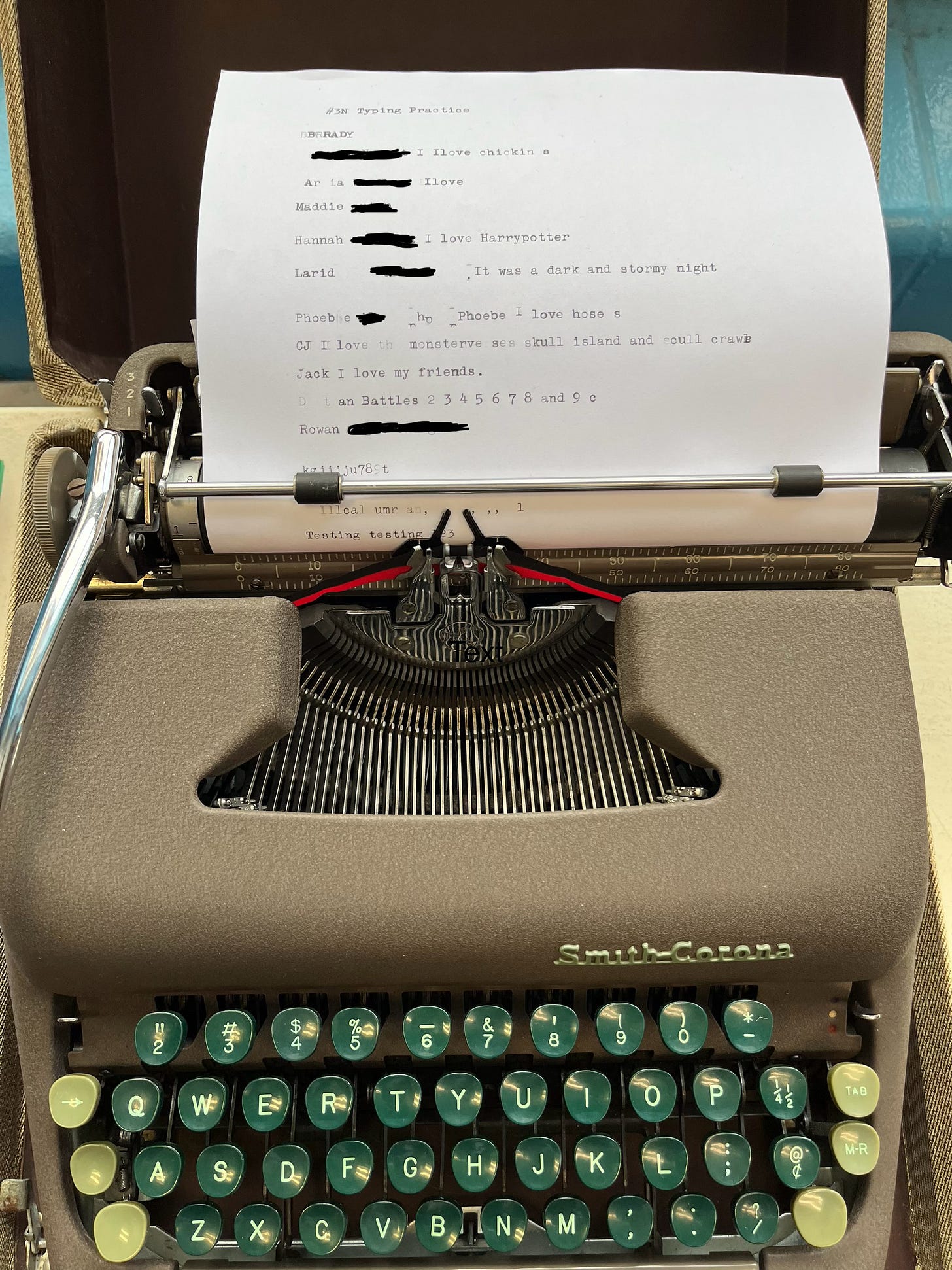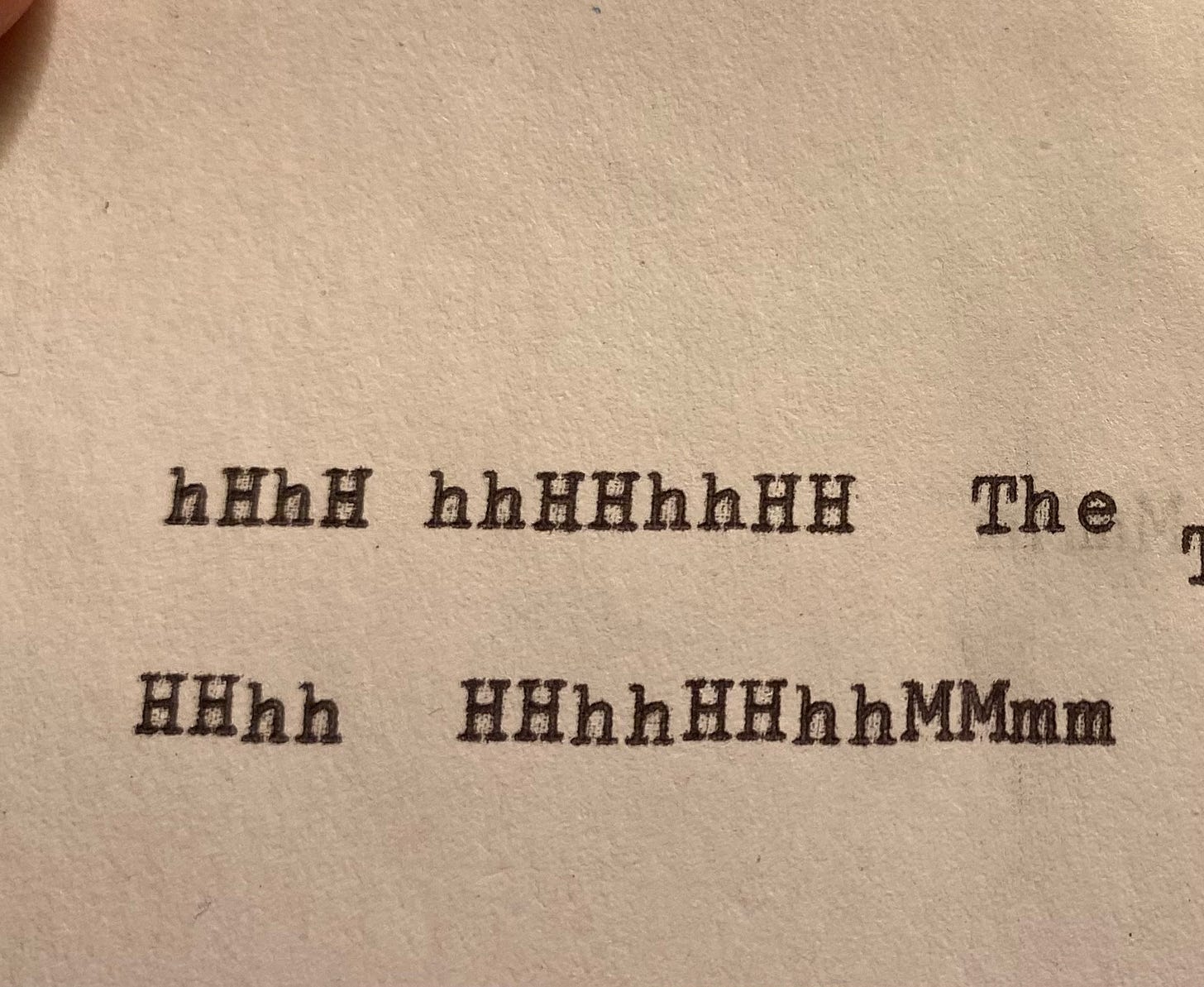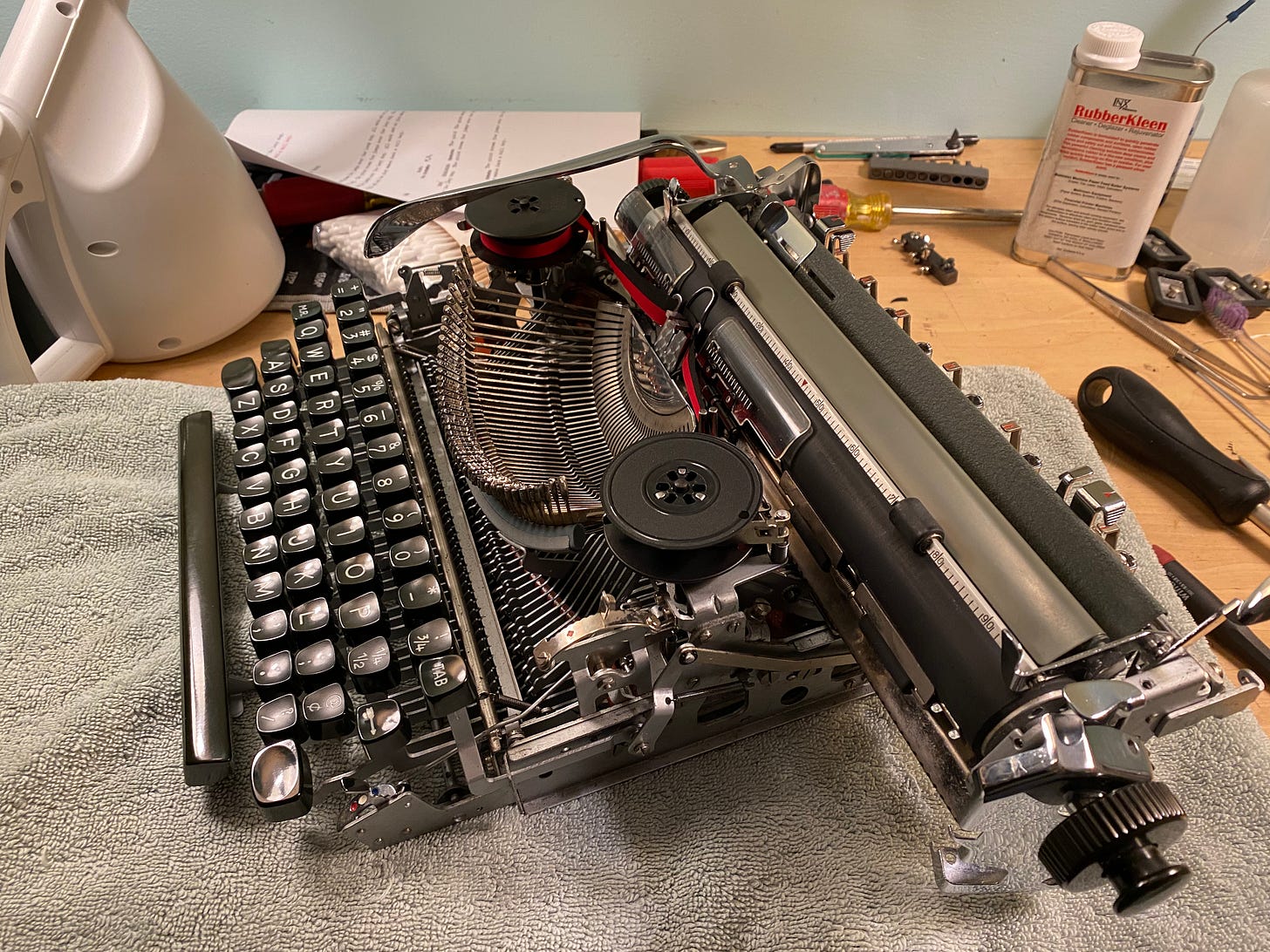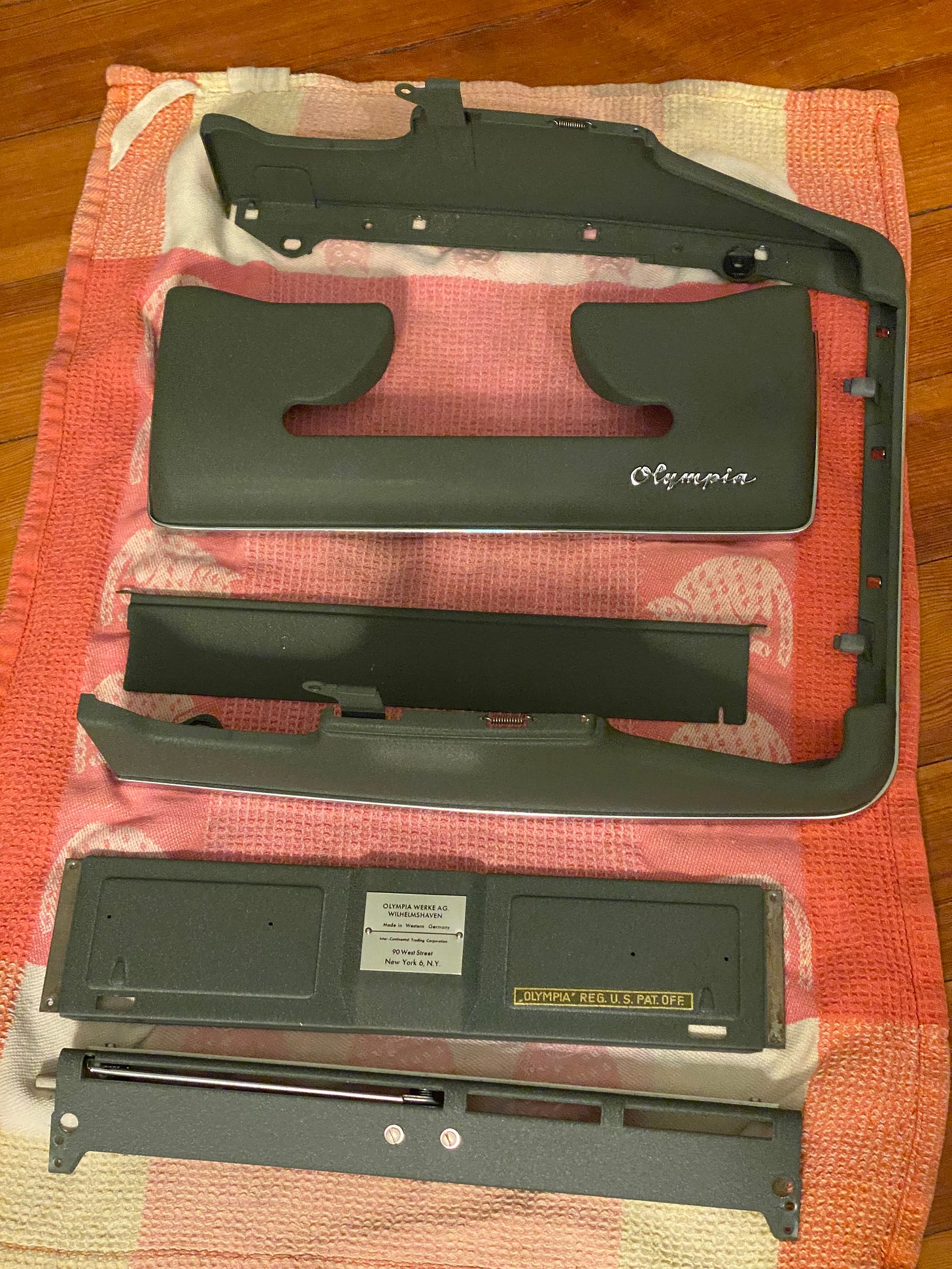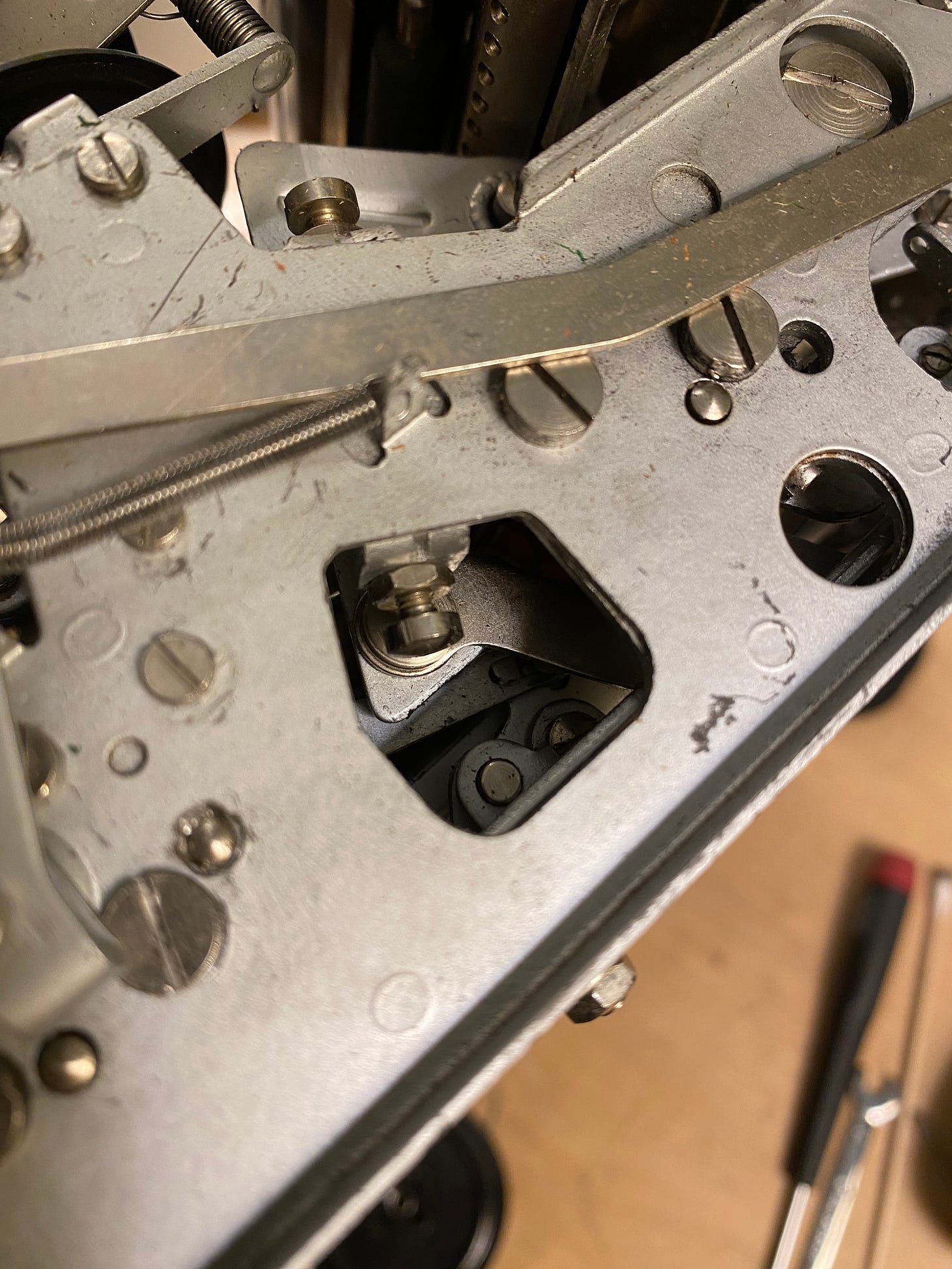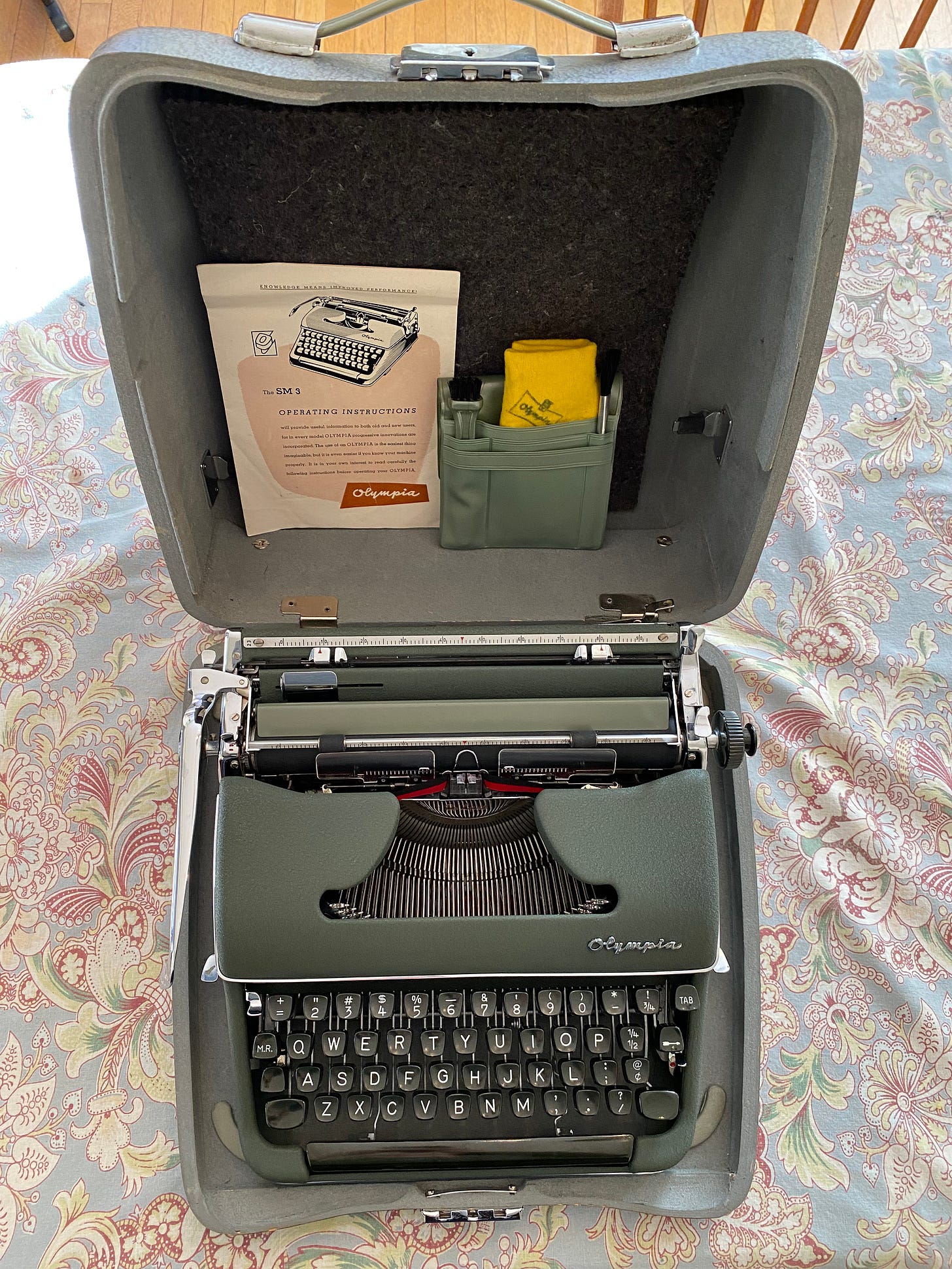Typewriter-ing 2. Reasons to Write on a Typewriter, or Your Father's Still Perfecting Ways of Making Sealing Wax
First-drafting, voice, and discovery
Typewriter-ing Part I Update:
The Smith-Corona Sterling arrived at the school library. Here are photos of some book labels created on the Sterling and a few things the 3rd graders typed. They did well!
The librarian said her students “line up whenever I open it up. It’s been a great addition to the school library.”
Santa’s Workshop Update:
More than a year ago, my daughter mentioned that a certain typewriter had caught her eye, an Olympia SM 3 which is a highly sought-after model. (What can I say? My daughter has excellent taste.) These tend to go for $600-900 on Etsy, so I kept my eye out for a decent fixer-upper at thrift stores until I finally found one. I restored it to give to her as a Christmas gift. It was in good condition for one made in 1958, not too dirty, no stale cigarette smoke stench or mildew scent which are common with typewriters until they are cleaned up, and no stuck or sluggish keys. Everything worked, but there was one problem: The type was misaligned.
The bottom line shows before I tinkered with it. (The upper line shows a close, but no cigar moment.) It should have been an easy fix, but the adjusting mechanism was deep inside the frame and inaccessible without taking the body apart.
After some trial and error, I got things lined up better.
Here’s how it turned out:
A thing of beauty. Damn, now I want one.
Typewriters and Voice or the Reason Why I Use Typewriters:
Typewriter enthusiasts always remind me of the Rolling Stones line, “Your father’s still perfecting ways of making sealing wax.” Now that I am among the enthusiasts, I can’t help wondering, What’s so wrong with perfecting sealing wax? My reaction to teaching on Zoom during the covid shutdown was to be more analog sometimes and get some relief from the digital age. I started writing with fountain pens and cool pencils first. Next I got my two Underwood typewriters out of the basement, had Tom at Cambridge Typewriter fix them up, and I experimented with writing first drafts on them.
The reason I had two Underwoods is because of family history. My grandfather worked at Underwood in Hartford for decades until he retired in the 1950s. I owned them for purely sentimental reasons. Once I visited Tom’s shop and saw his refurbished machines on display, I decided to get serious about using mine, at first just for the fun of it and as a kind of F-you to the Zoom era.
Though I enjoy analog things, I’m no Luddite and have been an early adopter of many types of electronic devices. I have nothing against a good MacBook and remember the early thrill from being able to rearrange paragraphs using copy-delete-and paste on word processors. That was no small thing after years of having to retype whole documents to do such things. It felt so freeing, and it was. Like most good things, however, there is a downside. The ease of making improvements to a document can get in the way, can stop you from advancing as you try to perfect that sentence or that paragraph.
The enthusiasts give various reasons for choosing typewriters for writing, mostly to do with avoiding the distractions that invade your train of thought while you’re writing on a computer. That’s definitely a plus, as long as all your devices are in some other room while you use your typewriter. It’s a good reason, and every writer should try it for a while.
Other reasons they list include the feel and sound of typing with a typewriter, particularly a manual one, which may take some getting used to, but once you do, it’s glorious. There is a subset of computer users who understand this. They build custom keyboards for their computers in an attempt to capture some of that typewriter feel. One of my students wrote about trying to get just the right “thock” sounds for his keyboard. What he seemed to be doing was approximating aspects of the typewriter experience even though he had probably never used one!
The tactile aspect is big, but that’s not the reason I’m encouraging you to try. Here’s why: When I write on a typewriter, I become someone else. My voice changes. I’ve been trying to figure out why. It’s not a case of cosplaying an old-school newspaperman. I don’t put on a fedora and light up a cigarette. It’s not some nostalgia trip. There is a practical side.
I subscribe to the “Shitty First Drafts” idea that Anne Lamott writes about. The point is to get something written no matter how it turns out because at least then, you’ll have something to revise. I’ve practiced this when writing on computers for years but now, even more so on a typewriter because I’m a lousy typist, and I have no choice. The point is to come up with a shitty first draft, typos and all. On a computer, though, because it’s so easy to fix things, it’s easy to get compulsive about it. Since I cannot fix things easily on a typewriter, it keeps me moving ahead. I’m not fiddling with corrections or rearranging things because either it’s impossible or too tedious.
Fixing a typo would mean instead of backspacing and retyping, you have to move the carriage all the way to the right, scroll the page up to isolate the mistake on the eraser table (provided you have erasable bond paper which you’d need to buy vintage), erase the mistake, brush the shavings aside without dropping too many into the typewriter works, guide the paper back to the precise spot where the mistake occurred, line everything up exactly, and then fix the mistake without mistyping again (no easy trick for me). To switch the order of paragraphs, which is a breeze on a computer, you’d need scissors and paste.
Ha! I guess I just talked you out of writing on a typewriter, but hear me out. On a typewriter, I am forced to be in a first-draft mindset, forced to escape any tendencies toward perfectionism, and this frees space in my brain that would normally be taken up with second-guessing and editing my thoughts. (Young-ha Kim calls such internal interferences “artistic devils.”) Not only am I eliminating interruptions from texting and social media, etc., I’m eliminating interruptions from my inner critic, which then calms down, allowing me to get into a quieter, trance-like zone. There’s no pressure to get it right because I’m not trying to get it right, so my writing is looser and more spontaneous. And when you are looser and more spontaneous, you are more likely to type something that surprises you and leads you down a path you never expected to walk down. That’s when the world melts away, which is my favorite part of writing.
On a typewriter, my body is in motion in a different way. (This is why Lynda Barry advocates writing by hand which I also advocate.) The motions on a typewriter are much more forceful and include different hand and arm movements that range from swiping the return lever each time the bell rings to rolling in a new sheet of paper every once in a while. When it comes down to it, I am printing, not just typing. I have freshly printed material right before my eyes, not a backlit screen. It’s not a bunch of ones and zeros creating the illusion of text. The printed material exists in the world, not the cloud, wherever that is. Yes, you will have to scan to text later—or better yet, retype to get it into your word processor. The benefit of retyping is that you are tricking yourself into revising, and you’ll hardly notice that’s what you are doing.
In my case, time travel may be a factor as well. I am writing in the way most people wrote for most of the twentieth-century, so it’s easy to get in the spirit since it’s how I wrote when I was young. There is still some muscle memory there, I suppose. Of course, if you are not one of the olds like me, this won’t happen for you in the same way. Still, the connection to previous eras may resonate enough to help you step away from your current self for a time, and who wouldn’t want that?
Besides, the machines are just plain cool, which will make you feel cool. Like I said, if you are a writer, you should consider writing with a typewriter sometimes. It might change your writing. In an upcoming newsletter, I’ll offer some tips on what to look for and how to put your hands on one for a reasonable price.
The subject of owning a typewriter makes me recall an old Lay’s potato chips slogan, “Betcha can’t eat just one.” Likewise, it’s difficult to stop at one typewriter. You have been warned.




